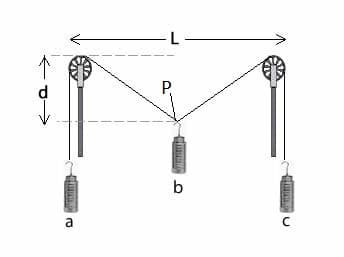Solve your equations for the vertical displacement (d) of object B in terms of the mass (M) of object B, the mass (m) of objects A and C, and the horizontal distance (L) between the pulleys. Your final equation should not depend on angles.
Solve your equations for the vertical displacement (d) of object B in terms of the mass (M) of object B, the mass (m) of objects A and C, and the horizontal distance (L) between the pulleys. Your final equation should not depend on angles.
Elements Of Electromagnetics
7th Edition
ISBN:9780190698614
Author:Sadiku, Matthew N. O.
Publisher:Sadiku, Matthew N. O.
ChapterMA: Math Assessment
Section: Chapter Questions
Problem 1.1MA
Related questions
Question
*PLEASE SOLVE #4*
The system consists of a central object, B, suspended halfway between two pulleys by a string. The whole system is in equilibrium. The counterweight objects A and C, which have the same mass, allow you to determine the force exerted on the central object by the string.
- Draw a picture of the setup similar to the one in the Equipment section. Be sure to include symbols for the horizontal distance L, and the mass of object B and objects A and C. Label the angle that the string sags below the horizontal as theta () and the displacement of point P as “d”. Use trigonometry to show how the vertical displacement (d) of object B is related to the angle theta and the horizontal distance L.
- Draw separate free-body diagrams of the forces on objects A, B, and C. Is there a difference between the force on mass B and at point P? Assign symbols to all of the forces, and define what they represent next to your diagram. It is also useful to put the force
vectors on a separate coordinate system for each object (force diagram). Remember that on a force diagram, the origin (tail) of all vectors is at the origin of the coordinate system. - Since this is a static situation, what is the acceleration for each object? For each force diagram break all forces into their x and y components and write down Newton's 2nd law along each coordinate axis.
- Solve your equations for the vertical displacement (d) of object B in terms of the mass (M) of object B, the mass (m) of objects A and C, and the horizontal distance (L) between the pulleys. Your final equation should not depend on angles.
- Use your equation to sketch the shape of the graph of the vertical displacement (d) versus mass of object B.

Transcribed Image Text:d
P.
b
a
Expert Solution
This question has been solved!
Explore an expertly crafted, step-by-step solution for a thorough understanding of key concepts.
This is a popular solution!
Trending now
This is a popular solution!
Step by step
Solved in 2 steps with 2 images

Knowledge Booster
Learn more about
Need a deep-dive on the concept behind this application? Look no further. Learn more about this topic, mechanical-engineering and related others by exploring similar questions and additional content below.Recommended textbooks for you

Elements Of Electromagnetics
Mechanical Engineering
ISBN:
9780190698614
Author:
Sadiku, Matthew N. O.
Publisher:
Oxford University Press

Mechanics of Materials (10th Edition)
Mechanical Engineering
ISBN:
9780134319650
Author:
Russell C. Hibbeler
Publisher:
PEARSON

Thermodynamics: An Engineering Approach
Mechanical Engineering
ISBN:
9781259822674
Author:
Yunus A. Cengel Dr., Michael A. Boles
Publisher:
McGraw-Hill Education

Elements Of Electromagnetics
Mechanical Engineering
ISBN:
9780190698614
Author:
Sadiku, Matthew N. O.
Publisher:
Oxford University Press

Mechanics of Materials (10th Edition)
Mechanical Engineering
ISBN:
9780134319650
Author:
Russell C. Hibbeler
Publisher:
PEARSON

Thermodynamics: An Engineering Approach
Mechanical Engineering
ISBN:
9781259822674
Author:
Yunus A. Cengel Dr., Michael A. Boles
Publisher:
McGraw-Hill Education

Control Systems Engineering
Mechanical Engineering
ISBN:
9781118170519
Author:
Norman S. Nise
Publisher:
WILEY

Mechanics of Materials (MindTap Course List)
Mechanical Engineering
ISBN:
9781337093347
Author:
Barry J. Goodno, James M. Gere
Publisher:
Cengage Learning

Engineering Mechanics: Statics
Mechanical Engineering
ISBN:
9781118807330
Author:
James L. Meriam, L. G. Kraige, J. N. Bolton
Publisher:
WILEY